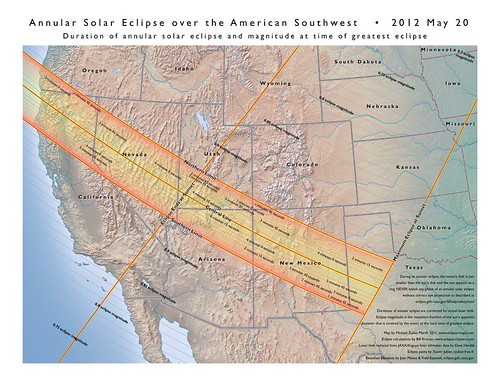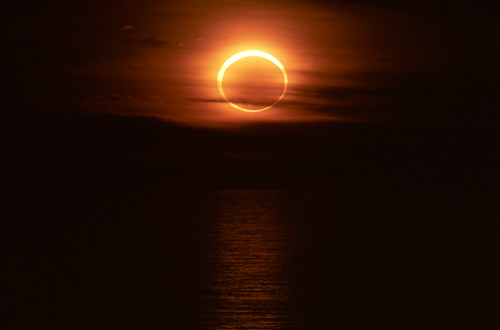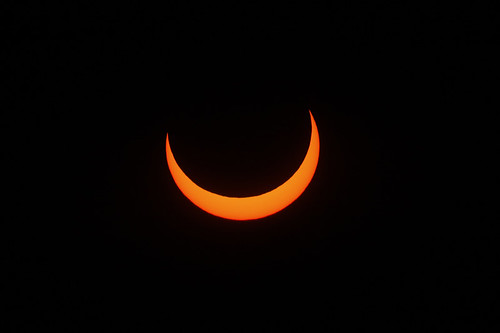Get your eclipse glasses, pinhole viewers, or Shade 14 welder’s glass out, and your “penumbras and emanations” jokes ready, because there’s a solar eclipse a-comin’ on Sunday evening!
The photo above (by Kevin Baird) shows roughly what the eclipse will look like along the central “line of annularity,” which stretches from parts of China and Japan, across the Pacific, to parts of California and Oregon, Nevada, Utah, Arizona, extreme southwestern Colorado, New Mexico, and northwest Texas:


(Graphics via eclipse-maps.com.)
Here in Denver, the eclipse, at its 7:30 PM peak, will look more like this, with the sun 86% eclipsed. (Photo by Peter Rosen, via Universe Today.)
If you don’t already have eclipse glasses, and you can’t find a local store that’s selling them at this late date, your best options, in order, are probably: 1) find a public eclipse-viewing event in your local area where they’ll be giving eclipse glasses away, or selling them for like $2 (here in Denver/Boulder, options include CU, DU, and the DMNS); 2) find a local store that sells welding supplies, and buy some “Shade 14” welder’s glass (it must be 14, not 12 or a lower number); or 3) make a pinhole viewer, and project the Sun’s image instead of looking at it directly.
(Whatever you do, DO NOT LOOK DIRECTLY AT THE SUN WITHOUT PROPER EYE PROTECTION!!!. At no point during an annular or partial solar eclipse is it ever safe to do this. You could go blind.)
If you do manage to secure eclipse glasses or welder’s glass, consider it an investment. A Transit of Venus–only the second one since 1882, and the last until 2117–is coming next month (June 5, to be exact), and of course the August 21, 2017 total solar eclipse is something you should go ahead and put in your gCal, iCal or Outlook calendars right now. It’s absolutely not to be missed.



I am sure I knew the answer to this question at some point, but remind me, what makes it more dangerous to look at an eclipse vs. looking at the sun any other time?
Nothing, really, except the temptation to do so. Most of the time, it would never occur to anyone to, say, squint at look directly at the sun for several seconds, or stack sunglasses on top of one another and stare through them at the sun, etc. All of these things would be just as dangerous if you do them tomorrow as they were today, but nobody will try to do them tomorrow, so there’s no need for warnings. 🙂
I believe it actually is more dangerous to look at the sun during an eclipse than the rest of the time. Because of the lower light levels, the pupil will be more dilated during an eclipse than during normal time, and thus a greater area of the retina will be in danger from looking directly at the sun.